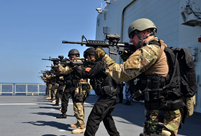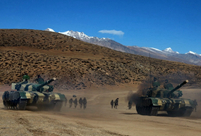 Army aviation: Adding wings to infantry
Army aviation: Adding wings to infantry
 Old photos of Chinese President Xi Jinping’s father and his families
Old photos of Chinese President Xi Jinping’s father and his families
 Bikini show in 2014 China Final of Miss Tourism World
Bikini show in 2014 China Final of Miss Tourism World
 Close-up view of August Aerobatic Team
Close-up view of August Aerobatic Team
 Goddesses married in 2014
Goddesses married in 2014
 Polar region photos raise worldwide awareness of global warming
Polar region photos raise worldwide awareness of global warming
 Get off at the last stop — Beijing Subway in vision
Get off at the last stop — Beijing Subway in vision
 Top 100 beauties in the world!
Top 100 beauties in the world!
 Gallery: Who is the most beautiful one?
Gallery: Who is the most beautiful one?
 If you like autumn, put your hands in the air!
If you like autumn, put your hands in the air!
PANGKALPINANG, Indonesia, Dec. 30 -- More countries on Monday joined the sea and aerial hunt for AirAsia flight 8501 which went missing a day earlier, but the collective effort achieved no significant result.
Indonesian Vice President Jusuf Kalla told a press conference at Surabaya airport that he received reports that an Australian Orion surveillance plane had spotted suspicious objects near the Nangka Island, 1,120 km from the location where the jetliner lost contact.
But he said could not confirm whether the objects belonged to the missing flight.
Meanwhile, Air Force spokesman Hadi Tjahnanto said an Indonesian helicopter had spotted an oil slick some 100 nautical miles (185 km) off the east coast of the Belitung Island, but he could not confirm whether it was fuel from the AirAsia aircraft.
Spokesperson Sutono for Indonesia's center of command for search operations, also said that there had been no credible evidence to confirm those reports.
The center, set up in the Pangkalpinang airport premises, supervises the joint international search for the missing plane, focusing on waters between Bangka Belitung and West Kalimantan provinces and the Karimata Strait.
"We will survey them again tomorrow. The search would still be conducted from sunrise to dusk. We have seven days to search for the plane, which could be extended depending on developments of search operations," Sutono, a senior official of the Indonesian Search and Rescue Agency (Basarnas), told Xinhua.
Earlier, an Indonesian official told the media that the missing jet with 162 people on board was believed to have sunken to the bottom of the sea.
"Because the coordinate that was given to us and the evolution from the calculation point of the flight track is at sea, our early conjecture is that the plane is at the bottom of the sea," said head of Basarnas Bambang Sulistyo.
Should the projection be true, Indonesia needs to cooperate with other countries to bring the wreckage to the surface, he added.
The United States said Monday that it was reviewing Indonesia's request for aid in locating the missing plane, which would take some time.
"The details of that request, which was made through the U.S. State Department, are still being coordinated but could include some air, surface and sub-surface detection capabilities," said the U.S. Department of Defense Press Secretary John Kirby in a statement.
China announced on Monday it will send aircraft and vessels to join the search and rescue work, with a navy frigate on routine patrol in the South China Sea heading for the waters where the jet went missing, and an Air Force jet making preparations and coordinations with the countries on the flight route.
Thailand and The Philippines have said respectively that they stand ready to extend assistance to the search operation, and a South Korean AP-3C Orion plane is scheduled to arrive on Tuesday. Singapore, Malaysia and Australia have sent planes and vessels to join the search operation.
As for the cause of the disappearance of the Airbus A320-200, an Australian aviation expert on Tuesday blamed it on human error, citing the fact that the pilots flew directly into a well-known danger zone above the Java Sea.
Expert Neil Hansford said that whoever plotted the flight plan made a fatal error, as veteran pilots avoided the area where the plane is believed to have gone down and would not fly through it.
The AirAsia flight bound for Singapore vanished from the radar screen at 6:17 a.m. local time Sunday (2317 GMT Saturday), 42 minutes after it took off from Surabaya.
The ill-fated plane lost contact with ground after the air traffic control consented to the pilot's request to change flight route due to a cloudy condition, but it did not approve his request to raise its height of flight to 34,000 feet (10,303 meters).
Of the 162 people aboard the flight, 155 were Indonesians, three South Koreans, and one person from Malaysia, Singapore, Britain and France each.
 Tempting Yunnan cuisine
Tempting Yunnan cuisine Joint anti-piracy drill
Joint anti-piracy drill PLA conducts tactical drill in Tibet
PLA conducts tactical drill in Tibet Beautiful Chinese woman
Beautiful Chinese woman Chestnut girl goes viral online
Chestnut girl goes viral online Time travel photos become a hit in military academies
Time travel photos become a hit in military academies Unknown 'monster' fish caught in Shandong
Unknown 'monster' fish caught in Shandong 20 years on: Relocated Three Gorges residents through lens
20 years on: Relocated Three Gorges residents through lens PLA HK Garrison veterans leave behind beautiful smiles
PLA HK Garrison veterans leave behind beautiful smiles New rules imposed on interbank deposits
New rules imposed on interbank deposits Mega project water arrives in Beijing
Mega project water arrives in Beijing Demonizing mega projects deters progress
Demonizing mega projects deters progress China steps up its overseas publicity efforts to mitigate negative reports on Tibet
China steps up its overseas publicity efforts to mitigate negative reports on TibetDay|Week|Month